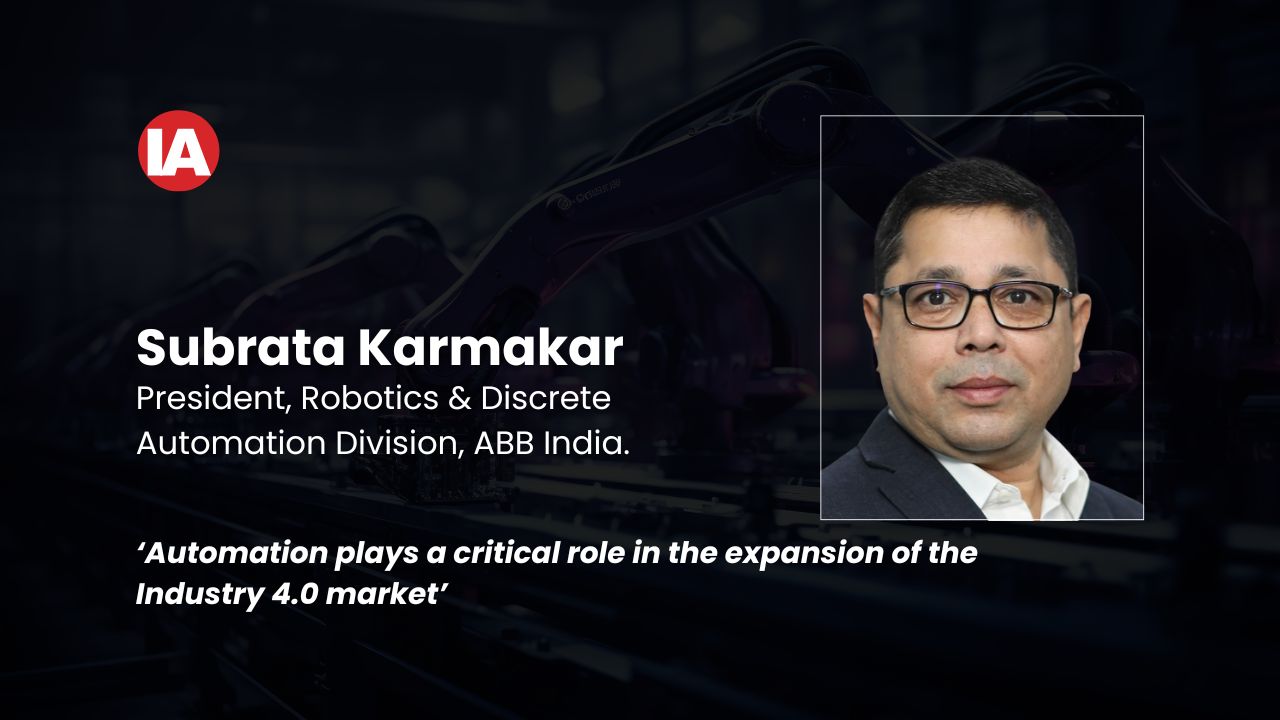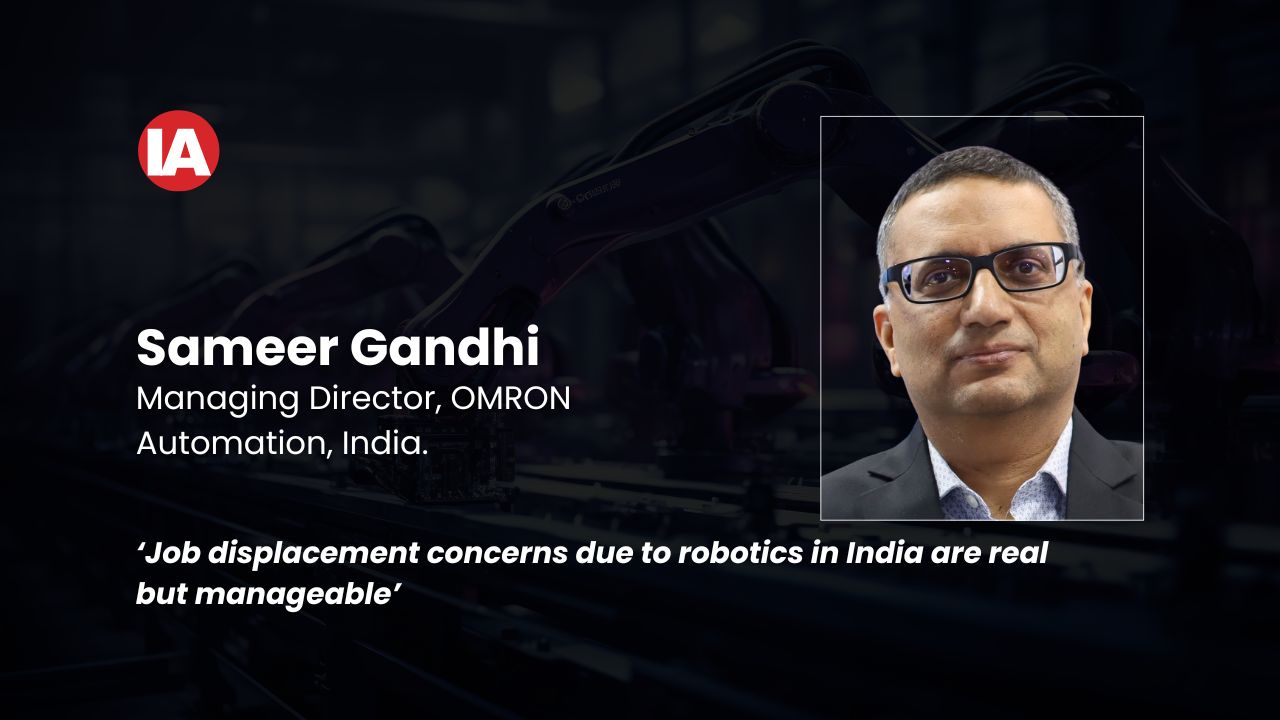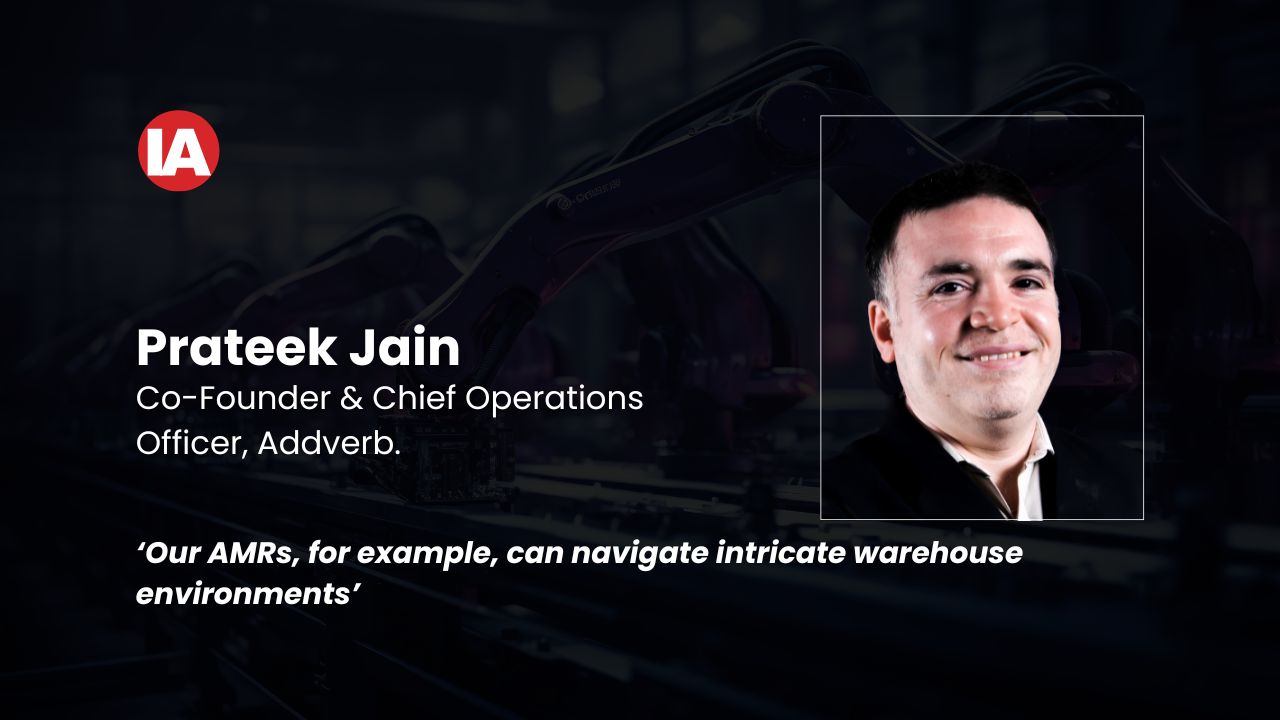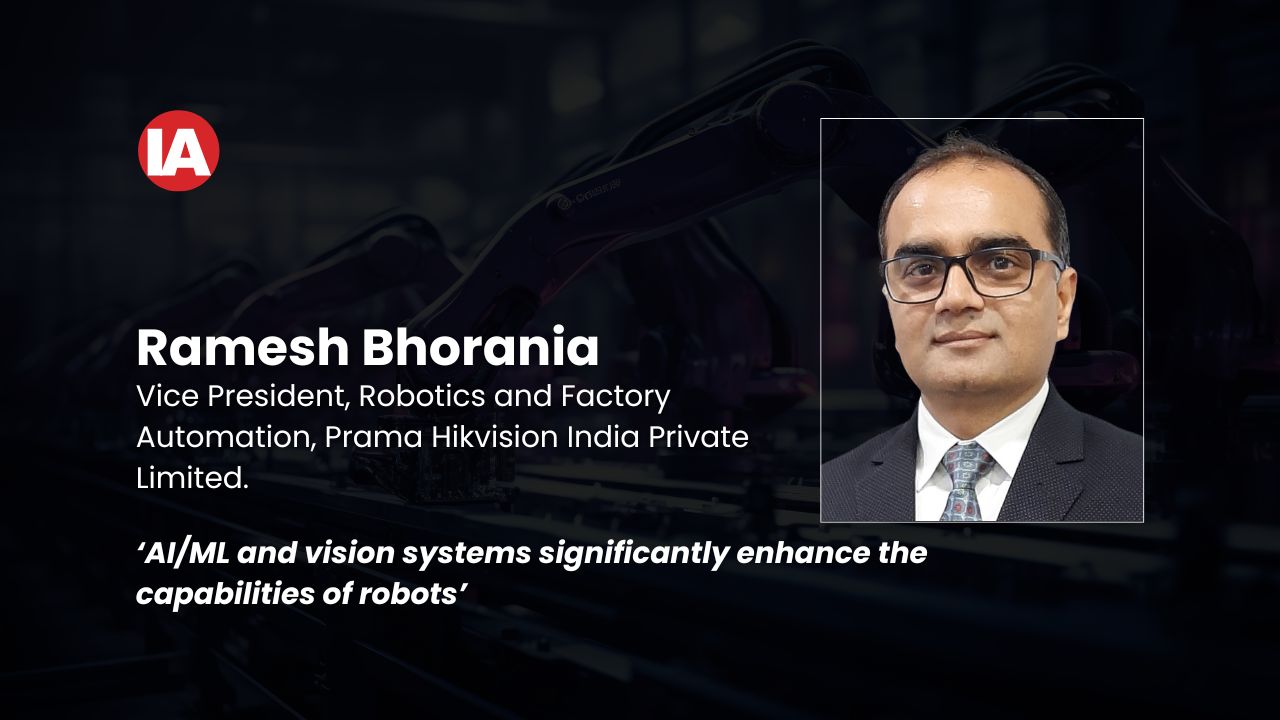May 01, 2025
Robots: Transforming the Future of Manufacturing
The integration of robots and collaborative robots (cobots) is significantly transforming India’s manufacturing landscape. From automotive to electronics, the adoption of automation is reshaping industries by improving efficiency, precision, and flexibility. Experts explore how this shift is enhancing productivity while addressing labor shortages and skill gaps, paving the way for Industry 4.0 in India.
![[object Object]](https://admin.industrialautomationindia.in/storage/cover_stories/coverstory-EfYWz0z5GccLtxNpFGACaLeSWUZ09RnFAyqZ8k5K.jpg)
Experts debate how the use of robots and cobots is changing the manufacturing landscape of India.
Robots are routinely deployed in industry for manufacturing and assembly operations; in machine tending and robotics cells; in automobiles – where these have been used extensively for welding, assembly and painting; in electronics and semiconductors for assembly and inspection; in packaging industry for carton forming, picking, placing, palletizing and packing; as autonomous mobile robots; and of late, in almost every industry to automate repetitive tasks.

Conventional industrial robots are now complemented by the gentle collaborative robots or cobots, designed for operating along with humans without the need for safety cages. One of the key aspects of Industry 4.0 is the concept of the ‘smart factory’, where machines, systems, and processes are interconnected and communicate with each other. Robots are integral to the realisation of smart factories. So how has the adoption of robots and cobots evolved in the manufacturing sector over the past decade?
“Over the past decade, industrial robots have moved from being a specialised solution to a central part of modern manufacturing, especially in high-volume and precision-driven sectors like automotive, metal fabrication, and electronics. In India, robot installations have seen a steady surge post-2020, driven by the push for automation and quality consistency,” says Ajay Gurjar, COO & Director, Robotics Division, Yaskawa India Pvt Ltd. “Alongside this, cobot have gained momentum – particularly in SMEs – due to their user-friendly operation, built-in safety features, and adaptability for tasks requiring human-robot collaboration.

Subrata Karmakar, President, Robotics & Discrete Automation Division, ABB India, draws attention to the fact that over the past decade, the adoption of robots and cobots in the manufacturing sector has witnessed significant growth, driven by various factors and resulting in substantial changes within the industry. “As of 2023, the global average robot density reached a record high of 162 units per 10,000 employees, more than double the figure from 2016, as noted in the World Robotics 2024 report. This surge highlights a broader trend towards automation, spurred by escalating labour costs across industries worldwide. Automation not only provides a more economical choice but also plays a critical role in the expansion of the Industry 4.0 market, which aims to enhance functionality, controllability, and safety in industrial environments,” he notes.

“Over the past decade, India’s manufacturing sector has seen gradual but steady adoption of robots and cobots, driven by rising labour costs, skill shortages, and global competitiveness demands. Initially, automation was limited to large automotive and electronics firms using industrial robots for welding, painting, and assembly,” says Sameer Gandhi, Managing Director, OMRON Automation, India. “However, post-2015, the adoption has grown led by many factors such as the initiatives like Make in India, more deployment of automation by SMEs, particularly in packaging, machine tending, and warehousing (accelerated by COVID-19 pandemic) and e-commerce giants and EV manufacturers deploying robots for logistics and production. Despite this growth, India’s robot density remains low (5-6 robots per 10,000 workers as per the International Federation of Robotics) compared to global leaders, mainly owing to high costs and skill gaps,” he adds.

Prateek Jain, Co-Founder & Chief Operations Officer, Addverb, believes the manufacturing industry has seen a significant change in the way automation is viewed and implemented during the last ten years. “In the past, industrial robots were mostly employed in the automotive industry to perform repetitive tasks in controlled settings. These robots were only practical for large businesses due to their high capital and infrastructure requirements, as well as the fact that they were frequently housed behind safety cages. But the automation landscape has changed with the emergence of Industry 4.0 and, more recently, Industry 5.0. Wider use of robots and collaborative robots (cobots) has been made possible by labour- intensive operations, smart factories, and the need for production agility. Instead of replacing human workers, cobots have become a solution to assist them,” he emphasises.
While the automotive industry is leading the robots race, incorporating them in almost every stage of manufacturing, which industries or manufacturing processes are seeing the most significant adoption of robotic automation?

According to Ramesh Bhorania, Vice President, Robotics and Factory Automation, Prama Hikvision India Private Limited, many industries are now seeing significant
adoption of robotic automation. These include:
Manufacturing Sector: Automotive industry with 1,148 industrial robots per 10,000 employees, has witnessed substantial robot installations.
Assembly Line Robotics: Robots deliver speed, precision, and adaptability, making them crucial in modern manufacturing.
Healthcare: Robotics and automation improve precision and accuracy in surgical procedures.
- Rehabilitation: Robots aid in patient rehabilitation, enhancing recovery and care.
- Diagnostics: Automated systems enable efficient and accurate diagnostic testing.
- Patient Care: Robots assist in patient care, reducing workload for healthcare professionals.
Logistics:
- E-commerce Fulfillment Centers: Robotic systems optimise warehouse management and order fulfillment.
- Material Handling: Autonomous Mobile Robots (AMRs) transport materials efficiently, reducing manual labour.

Smart Manufacturing:
- Industry 4.0: Robotics and automation converge with digital technologies, enabling smart factories and predictive maintenance.
- Collaborative Robots (Cobots): Cobots work alongside human workers, enhancing productivity and efficiency.
“The automotive industry remains a leading adopter of robotic automation, leveraging robots for tasks like assembly, welding, and painting to achieve high precision and efficiency. Beyond automotive, sectors such as electronics, food and beverages, and pharmaceuticals are increasingly integrating robots into their operations,” says Dr. Sanjeev Srivastava, Head Industrial Automation Business, Delta Electronics India. “Delta Electronics has responded to this trend by offering solutions like four-axis SCARA robots for low payload applications and six-axis articulated robots for complex tasks, including inspection, assembling, and packaging. The company has also observed a rising interest from small shops and micro-industries, indicating a broadening scope of robotic applications across various manufacturing processes,” he informs.

Shubhankar Chatterji, Chief Supply Chain Officer, Cummins India, opines that certain industries are at the forefront of robotic automation, driven by high RoI and the need for precision and speed. These sectors benefit significantly from robotic integration due to their reliance on repetitive tasks and the necessity for process precision, which offsets costs like energy, yielding a strong competitive edge. “Leading the charge is the e-commerce sector. Companies have transformed warehousing, sorting, and logistics through a blend of Industry 4.0 technologies, digitalisation, and robotics, significantly improving operational efficiency. Similarly, the automotive, semiconductor, machinery, computer, and hardware industries are major adopters of robotic automation. These sectors capitalise on robotic technology to enhance efficiency, precision, and production speed, aligning technology with strategic business goals to drive remarkable growth and innovation,” he points out.
Collaborative robots or cobots are now gaining in popularity. What are the key factors driving the increased use of cobots over traditional industrial robots?
Ajay Gurjar emphasises that industrial robots continue to be the backbone of high-speed, high-precision manufacturing, especially in sectors like automotive (including EVs), electronics, and heavy metal fabrication. Their strength, accuracy, and ability to handle repetitive, large-scale production make them indispensable in such industries. “At the same time, cobots are gaining ground in areas that demand flexibility and human-robot interaction. Sectors like automotive, FMCG, furniture, logistics, and healthcare are adopting cobots for tasks such as assembly, inspection, and packaging. Their safe operation near humans, ease of programming, and adaptability to high-mix, low-volume production environments make them a smart complement to traditional robotics,” he observes.
“The rise in cobots is driven by labour shortages and the need for flexible automation solutions. By 2023, cobots made up 10.5% of industrial robot installations globally. They are popular due to their easy programming – often through intuitive hand-guiding or tablet interfaces – and typically need no additional safety measures, allowing seamless integration into existing production spaces without the need for fencing,” says Subrata Karmakar. “A prime example is ABB's GoFa™ cobots, which feature the Ultra Accuracy capability, delivering the highest precision level in cobots, with over 10 times greater path accuracy, making them ideal for industries with high accuracy demands, such as electronics and assembly,” he explains.
Sameer Gandhi believes the growing adoption of cobots over traditional industrial robots in India is primarily driven by their lower cost, flexibility, and ease of deployment, making them ideal for SMEs with limited capital and space. “Unlike industrial robots, cobots require no safety cages, can work alongside humans, and are easily reprogrammable for diverse tasks – key advantages in India’s labour-intensive manufacturing landscape. Additionally, rising wages, labour shortages, and government incentives (like PLI schemes) are pushing industries like automotive ancillaries, electronics, and FMCG toward cobots for tasks such as assembly, packaging, and quality inspection, where precision and adaptability matter more than sheer speed or payload capacity,” emphasises.
Emerging technologies are enhancing the capability of robots turning ideas into action. How do AI, machine learning, and vision systems enhance the capabilities of robots in manufacturing?
“AI, machine learning are the technologies which allow robots to sense, interpret, decide and act- moving beyond predefined, static functions. They enhance performance across inspection, sorting, navigation, and predictive maintenance,” says Prateek Jain. “At Addverb, we create embodied AI systems, which are robots that use computer vision and machine learning algorithms to continuously learn from their surroundings. Our autonomous mobile robots, for example, can navigate intricate warehouse environments without the need for predetermined routes thanks to real time vision systems. Our software incorporates machine learning models that analyse operational parameters such as heat signatures, and movement patterns to enable predictive maintenance,” he adds.
Ramesh Bhorania agrees that AI, machine learning and vision systems significantly enhance the capabilities of robots in manufacturing. This is achieved by the following means:
Improving Accuracy and Precision: Machine learning algorithms enable robots to learn from data and improve their performance over time.
Enhancing Flexibility and Adaptability: AI-powered robots can adapt to changing production needs and learn to perform new tasks.
Enabling Real-Time Decision-Making: Vision systems provide real-time data, enabling robots to make decisions and take actions quickly.
Increasing Efficiency and Productivity: AI-optimised robots can optimise production processes, reducing waste and improving efficiency.
Some key applications include:
Quality Inspection: Vision systems enable robots to inspect products and detect defects.
Object Recognition: AI-powered robots can recognise and classify objects, enabling efficient sorting and processing.
Predictive Maintenance: Machine learning algorithms enable robots to predict maintenance needs, reducing downtime.
“By integrating AI, machine learning, and vision systems, robots can perform complex tasks with increased accuracy, efficiency, and flexibility, transforming manufacturing processes,” says Ramesh Bhorania.
According to Dr. Sanjeev Srivastava, the integration of AI, machine learning, and vision systems significantly amplifies robotic capabilities:
1. Advanced Sensors and Machine Vision: Cobots equipped with advanced sensors and machine vision can perform tasks requiring high precision and adaptability, such as assembly and inspection.
2. Adaptive Learning: AI enables robots to learn from data, allowing them to adjust to variations in tasks and environments, thereby improving efficiency and reducing errors.
3. Predictive Maintenance: Machine learning algorithms can predict equipment failures before they occur, facilitating proactive maintenance and minimising downtime.
“Delta Electronics has embraced these technologies, utilising AI-assisted Automated Optical Inspection (AOI) to accelerate inspection processes and detect defects early, thereby reducing
the need for manual intervention,” he notes.
One of the major concerns when it comes to use of robots in manufacturing is the human element – robots are taking away jobs from human workers. How true are these concerns about job displacement, and how can companies address workforce transition challenges?
“Automation and AI simultaneously create new opportunities for workforce development and innovation. Companies can address the transition challenges by implementing strategies that focus on upskilling and reskilling employees for high-value roles, says Shubhankar Chatterji. “For instance, transitioning factory workers into skilled roles such as robot maintenance technicians or programming experts not only preserves jobs but also enhances workforce capabilities, making them essential in an automated landscape. Investing in comprehensive training programs is essential, covering topics from basic robotics and AI principles to advanced programming and maintenance techniques. By offering these learning opportunities, companies empower their employees to remain relevant and competitive,” he elaborates.
Ramesh Bhorania agrees that there are concerns about job displacement due to automation and robotics. But he says companies can address workforce transition challenges by:
Upskilling and Reskilling: Providing training and development programs to help employees acquire new skills.
Redeployment: Redeploying employees to new roles that are created by automation.
Communication and Transparency: Communicating changes and providing transparency about the impact of automation on jobs.
Support and Resources: Offering support and resources to employees who may be displaced.
Focusing on Human-Centric Tasks: Automating repetitive and mundane tasks, allowing humans to focus on high-value tasks.
“Some companies are also exploring new business models that prioritise human-AI collaboration, creating new opportunities for employees to work alongside technology. By taking a proactive and strategic approach, companies can mitigate the negative impacts of job displacement and create a more sustainable future for their workforce,” he explains.
Subrata Karmakar, too believes that in order to address workforce transition challenges, companies must invest in workforce training and education. This involves developing programs that equip employees with the necessary skills to operate alongside advanced robotic systems. “A focus on reskilling and upskilling is crucial, fostering adaptability and technical proficiency, ensuring that workers can thrive in an increasingly automated environment. Such initiatives not only help businesses embrace robotics effectively but also ensure workforce stability and growth during this technological shift,” he suggests.
“Job displacement concerns due to robotics in India are real but manageable, particularly in labour-intensive sectors like textiles, automotive assembly, and low-skill manufacturing, says Sameer Gandhi. “OMRON believes that we can create harmony between people and machines on the floor rather than positioning them against each other. The vision needs to enhance human beings` capabilities with the use of robots. The aim of Robotics deployment is to take over repeated or heavily manual and hazardous tasks and create new high-skilled jobs in return,” he opines.
Given the rapid pace of tech evolution, what are the biggest innovations in robotics one can expect to see in the next 5-10 years?
“Humanoid robotics, multi-agent robot coordination, embedded artificial intelligence, and energy-efficient automation will all see significant advancements over the course of the next ten years,” says Prateek Jain. “Our first humanoid robot with dual-arm functionality, bipedal locomotion, and natural language processing (NLP) skills is presently being constructed at Addverb. This robot is being developed for industries where human-like mobility and interaction are essential, such as healthcare and logistics,” he adds.
For Ajay Gurjar, key areas include AI-integrated cobots, mobile manipulators, energy-efficient robots, real-time edge computing, and no-code programming. The future is flexible, intelligent, and collaborative. “Yaskawa’s MOTOMAN NEXT robot is already paving the way – combining precision, adaptability, and advanced motion control to meet the evolving demands of modern manufacturing. With continued innovation, MOTOMAN NEXT aims to lead the next era of smart, connected, and human-friendly automation,” he informs.
“The next decade is poised to witness significant innovations in robotics,’ asserts Sanjeev Srivastava. According to him these include, but are not restricted to:
- Enhanced Human-Robot Collaboration: Advancements in sensor technology and AI will lead to more intuitive and safer interactions between humans and robots, expanding the scope of collaborative applications.
- Integration with Industry 4.0: Robots will become integral components of interconnected manufacturing ecosystems, facilitating real-time data exchange and adaptive manufacturing processes.
- Mobile and Autonomous Robots: Development of autonomous mobile robots capable of navigating dynamic environments will revolutionise material handling and logistics within manufacturing facilities.
“Delta Electronics is committed to staying at the cutting edge of these innovations, as evidenced by its ongoing investments in R&D and the introduction of advanced robotic solutions like the D-Bot series cobots,” he says.
Shubhankar Chatterji believes advances in machine vision and real-time decision-making will enable robots to tackle intricate and unforeseen tasks with minimal programming, resembling skilled workforce adapting to new challenges. “Soft robotics and adaptive grippers will revolutionise delicate object handling, allowing robots to manipulate fragile items with the gentleness of a human touch. Swarm robotics could transform large-scale logistics, as fleets of robots collaborate seamlessly to manage complex operations. This will drive factories not only to produce goods efficiently but to minimise environmental impact, contributing to a greener future,” he concludes.
Note: The responses of various experts featured in this story are their personal views and not necessarily of the companies or organisations they represent. The full interviews are hosted online at https://www.iedcommunications.com/interviews)